HeroMystic
Legacy of the Mario
- Joined
- Aug 3, 2008
- Messages
- 6,473
- Location
- San Antonio, Texas
- NNID
- HeroineYaoki
- 3DS FC
- 2191-8960-7738
This is a VERY VERY LONG READ AND THERE IS NO TL;DR VERSION! Make sure you have a good amount of time to read this!
Mario’s Metagame Status
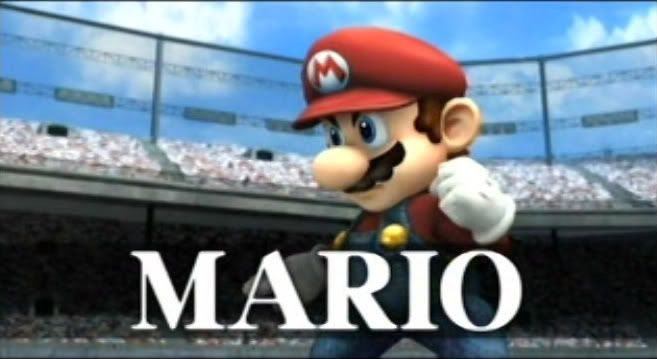
References
Mario Sucks~ The Comprehensive Guide to Mario
Lets'a Go! A2Z's Guide to Mario
FLUDD and Cape Guide
Mario Moveset Discussion
Mario Frame Data
Mario Combo List
NOTICE: This is not, in any shape or form, a guide to using Mario. It is a straightforward but thorough analysis on Mario in the current metagame (think SBR's analysis on characters). If you are reading this, it is assumed you know about Mario's metagame and do not need to be explained thoroughly the basics and techniques of the character. If you do not know of this, please look through the references before proceeding. I will not be explaining how things work!
Table of Contents
If colored in blue, then it is updated as of 2010. If colored in lime, then it is partially updated and is in process.
I - General Analysis [GA]
II - Moveset Analysis [MA]
III - Necessities [NS]
IV - Tactics [TC]
V - Metagame Improvements [MI]
General Analysis
[GA]In this current status, the general analysis is the same: Mario is a balanced character. He has an effective option for anything coming his way. His juggling, defensive traits, and most of all gimp ability are all accounted for.
Strengths
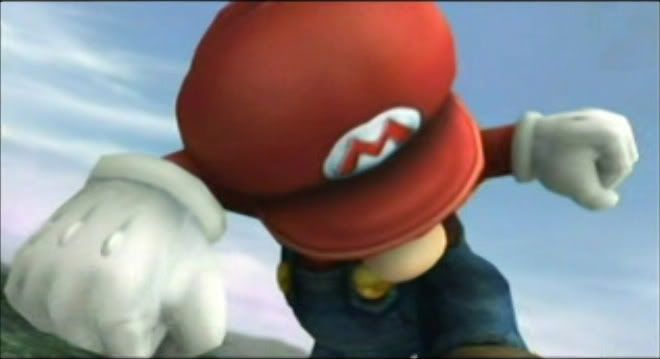

When I last made this I said his greatest strength is his reliability to gimp. That wasn't it. It's actually his large amount of mix-ups and options per situation which is his greatest strength. He never has just one effective way to fight per Match-up (except for Chaingrab), and it's that quality which effectively negates unwinnable match-ups.
That said, his particular strong points are still noticable. Opponents are still scared to death of the Cape, and his defensive tactics makes him particularly rough to combat easily. Up-B OOS is still noticable, and our tried-and-true GTFO move D-Smash is great. FLUDD gets a nod due to being an excellent positioning tool.
Mario is still a combo character, though U-air is being used less these days. Nowadays it's a combination of aerials mixed in with ground attacks to perform true combos. Something like N-air to jab is a true combo, and an Auto-cancel B-air to Pivot F-tilt is a true combo as well.
Weaknesses
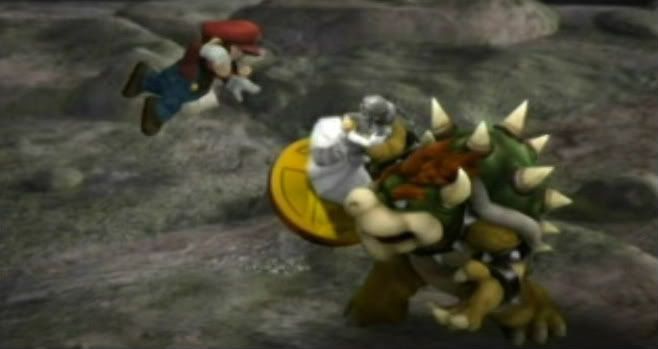

For the most part, Mario's weaknesses are still present.
If you read this before you'll notice I got rid of his ledge option weaknesses, which turns out have been minimized from a major weakness to simply an annoyance. While it's not a strong spot in Mario's game it's not a weakness either.2008 Analysis said:Let’s face it: A balanced character will have weaknesses, and the biggest one that really affects Mario is his general lack of range with all his moves. With the very low amount shield-stun in the game, the majority of Mario’s moves are all susceptible of getting shield-grabbed. There are a few things that cover this however, but I’ll get to that later.
Another weakness, and probably his most costly one, is the fact that his answers for every situation are overshadowed by another character that would have a better answer for said situation. This essentially means that for any given match-up, there will be other characters that are better to use against it. This is bad for Mario for the fact that he hardly has any match-ups where he is the best choice, but also works in his favor because he hardly has any match-ups where he gets decimated.
Though, while that is gone it is simply replaced with a new one: Mario is a character that relies on making openings and capitalizes on exploiting weakened traits. This varies from punishing laggy attacks to using vertical spacing against characters that regularly outrange Mario. Problem is, if an opening never comes up (or it doesn't get exposed enough), then Mario is in trouble. This doubly goes to Mario mains in which they require an extensive knowledge on all match-ups to know what options works and what doesn't. It is never an easy ride for Mario.
Moveset Analysis
[MA]Mario's moveset as a whole is pretty good, and each move has a use that can be used in battle. Theoretically, Mario has no useless move, but how far is the usefulness for each ability?
Note: Anything posted in blue will be as of 2010. There can be some analysis of certain moves that will not need any editing, just an update. If there needs to be a drastic change then it will be noted.
Standard Moves
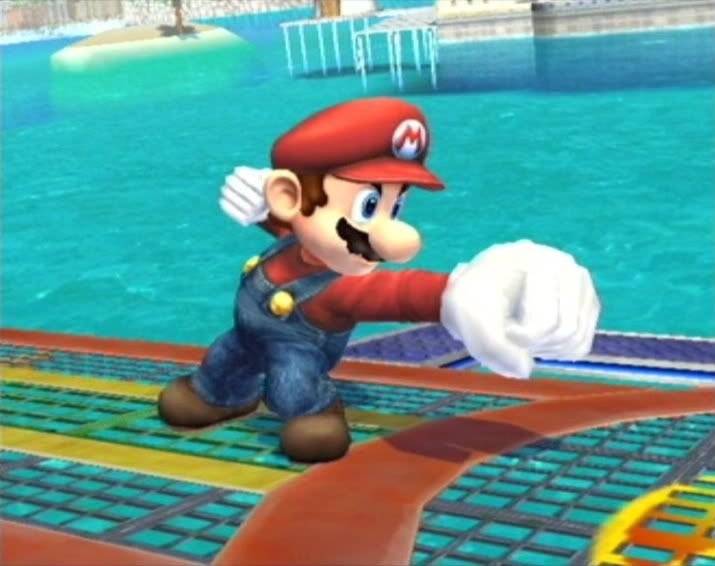

Jab - The standard PPK combo that many other characters love to replicate, but Mario is the original user of this and makes the best use of it. The three hits count as a separate hit, meaning that's three inputs to the stale move system. That's good! This means our abilities have the capability of quickly refreshing, especially since the jabs come in quick succession. It does a nice amount of damage; can jab cancel into grabs, D-Smash/Up-Smash, tilts, or just more jabs; and is a decent spacer. When you hold A, you can also start doing a rapid jab which allows Mario to punish spotdodging and makes SHADing harder to do against him. This is definitely a move you should use a lot, but smartly. Remember however that there are times when there are better options than jabbing, so don't use this too much.
2010 Update: The 2008 post holds true, but certain emphasis on some parts. Jab cancel is SUPER DUPER IMPORTANT and crucial to adding onto damage, which allows you to KO faster. A full combo does 9% damage. Jab-Jab-F-tilt (currently named the (true) PPK Combo) does 13% damage and it's unblockable on anything not Fox/Falco/Wolf, meaning it's true combo. It's also 3% less than Ike's full jab combo, which is the highest 3-hit jab combo in the game. Jab-Jab-D-Smash (currently named the Breakdance Combo) does a whooping 20% damage. That's just 1 point less than Snake's F-tilt.
A few notes is that for this to be unblockable, the first hit of jab needs to be sweetspotted (hitting with the fist and not the wrist/arm), and input of the jab-canceled action needs to be buffered so it'll act on the first IASA frame of the second jab. This has a 7-frame advantage, so any attack that comes out in 7 frames or less will work. This essentially goes for just about any ground move. We need to see this more. A lot more.
For more information go to Here, and Here. Both are very enlightening.
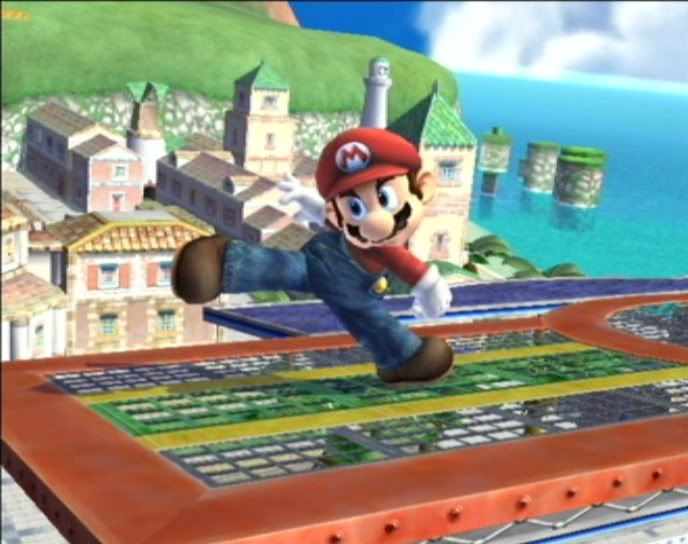
F-tilt - A simple move that brings plenty of reward. F-tilt is definitely a move that should be used more often in general. Despite the very low knockback, it's quick, has a nice amount of range, and low ending lag. This allows Mario to get in a semi-lock if the opponent is unaware, which quickly racks up damage. It's also a pretty decent OOS option that puts your opponent in a position to allow a follow-up. What stop Mario for using this a helluva lot more is the fact that it's a move that can be easily shield-grabbed if not spaced correctly, and the fact that it's main purpose (spacing) is easily overshadowed by other moves. However, this move is a good highlight of Mario's ground game, and should definitely be shown more in a competitive environment.
2010 Update: One thing to add on is F-tilt's IASA frames needs to be taken advantage of. F-tilt's range is actually really good as it can poke out of grab range and allows for a quick dodge to avoid being grabbed or attacked in general, and this is on block, so this is useful on anyone not named Chaingrab or Charizard.

U-tilt - Another good move for Mario's ground game, and is probably (over)used the most often. U-tilt's main use is for locking opponent is a seemingly endless chain of more U-tilts that lasts from 20% - 50% depending on opponent's weight and fall speed. A few characters easily break out of this however (Freaken Luigi), and there can be some instances where characters can jump out of it if the knockback is high enough. This makes the main purpose harder, but makes the secondary purpose simple: putting your opponent in the air. This makes aerial comboing viable and easy to execute.
Other uses?
U-tilt's vertical range is great, and is actually the best we have for a ground attack. This actually pokes out and can hit opponents off of platforms from below Battlefield. The quickness and priority is very noticable as well, which makes U-tilt an exceptional poker against aerial opponents like Luigi and Peach, and perfect for avoiding damage instead of always relying on OOS options.
Another thing to note is the set-ups that U-tilt can make. Once you U-tilt, there are oh-so-many options Mario can take. U-tilt going into a U-air is the usual, but one can also being charging U-Smash to punish a readable air-dodge. Or you can even U-tilt again if one predicts the opponent to retaliate.
Nonetheless the disadvantages of U-tilt are still there. Low horizontal range which makes the OOS function minimized, and that also hurts it's potential potential of being a good jab-cancel option. The option to be used as an emergency kill is still viable at over 150% pending weight and momentum cancel.
D-tilt - Pretty much the most worthless move, but there has been some things that can be found viable with D-tilt that doesn't completely banish it from competitive fighting. It has more range than jabs, and hits low enough that you can shield poke. What's the biggest pencil pusher for this move is that D-tilt has so little knockback that this can actually set up for a kill at high percents. So D-tilt > F-Smash or D-tilt > U-Smash are actually viable options as long as the opponent doesn't react accordingly.
However, the problems are still glaringly obvious. Large ending lag, low knockback, and poor for spacing. This is, as a whole, a mindgame tool and should be used sparingly.
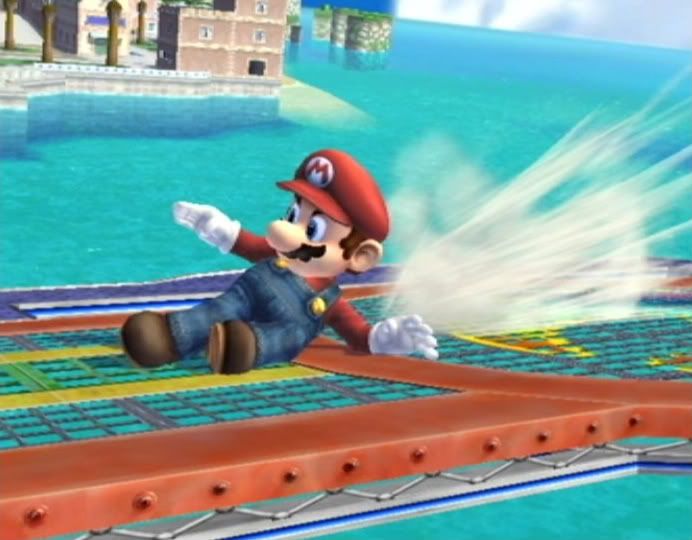
Dash Attack - Dash attack is a risky move that doesn't bring a lot of reward. For a dash attack however, it gets the job done. It's quick on execution, has a nice amount of priority, and can shield poke. The Dash attack has primary and secondary hitbox. The primary hitbox is the first half of the animation when Mario is dashing forward. The secondary hitbox is when Mario is slowing down. The primary hitbox sends opponents above and behind Mario, which is the perfect opportunity to lay out B-airs and play the chase game. The secondary hitbox makes the opponent flinch and sends him/her slightly above Mario, which is the perfect opportunity for Mario to use a u-tilt or U-Smash (for the kill?).
The move is a decent punisher, but more used as the "If there is nothing else..." move. When you're dashing to an opponent after he executed a laggy move, there can be times when Mario's aerials or tilts won't make it. That's when Dash attack comes in and allows you to punish to in time.
Problem is, this move is very, very, shield-grabbed due to it's properties and ending lag, and therefore should not be used commonly, but I do encourage to use this for shield-poking.
2010 Update: When using Dash Attack, you want to aim for attacking during the end of the attack. The recovery is quick enough so you can go into viable follow-ups with a much less window opportunity for your opponent to retaliate. This can go into something similar to D-tilt where you can use a smash attack for kills, or at lower percents set up into combos.
Another thing to note is that while damage and knockback decreases per frame of the attack, priority does not, and it's rather high. Dash Attack has the huge tendency to just clank with other attacks, making it more safe than initially thought. To lower the risk of whiffing with this attack, use fireball approaching.
Smash Attacks


F-Smash - With the implementation of Momentum Canceling, F-Smash has become far more important in terms of getting kills. It still kills at 105% (Angled Up) at the middle of FD, so the power of F-Smash is still vastly apparent. The knockback is very demanding of kills, so even the best momentum breakers have to give it their all in order to not get KO'd. Stutter-Step F-Smash is still excellent for punishing and mindgame potential. Of course, Stutter-Step F-smash isn't affected by sliding from shield hits as well, increasing it's punishing potential.
I however, want to go on a different direction for F-Smash and talk about it's damage. This does 18% when sweetspotted (the fire, obviously). That's only 3% less of Jab-Jab-Dsmash, and this is just one attack. Since F-Smash comes out in frame 15, this isn't an unblockable jab cancel option ( Awww... =( ), but it can still be used for a jab cancel mix-up. If the opponent doesn't react accordingly, consider it free damage(24%), or even a free kill, but you can even auto-cancel B-air, U-air, N-air into F-Smash for more damage. Heck, you even use a grounded D-air (which has fixed knockback at any %) into F-Smash. You only need 9 moves to refresh F-Smash after use, and that is easily done with fireballs, jabs, and other attacks. F-Smash does not need to be fresh the entire match to keep it's kill power, it just needs to never go stale. There's no need to be afraid to use F-Smash for sake of increasing damage, as long as it's fresh to kill when you need it. I wanna see how you guys go with this.
The problem are still there though. High Ending lag that leaves Mario vulnerable, so hitting is important. But that's about the only thing wrong with F-Smash. It does good in just about everything else.
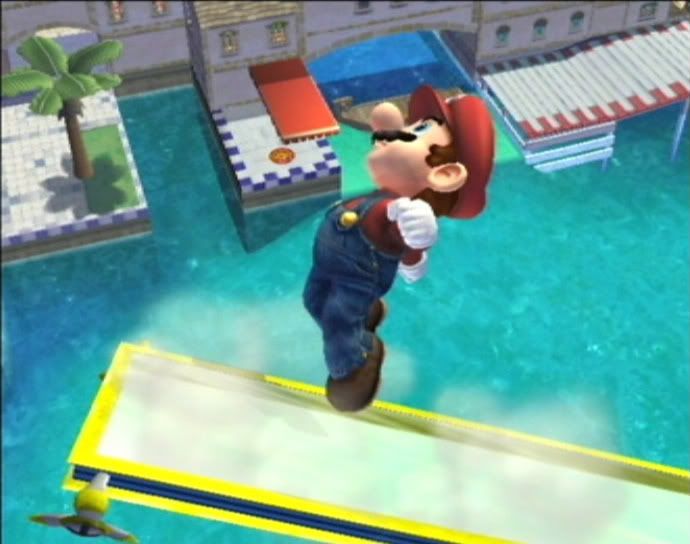
U-Smash -Along with F-Smash, U-Smash has increased in importance for getting kills. It kills at 130% in FD, but that's without DI and Momentum Breaking added on, so the kill potential is actually less in it's uncharged state. The great thing about U-Smash is the DACUS and Sliding U-Smash. DACUS doesn't slide as far but isn't as telegraphed, but Sliding U-Smash slides quite far (3rd of FD) charging U-Smash leads to KOs even as low as 90%. Thanks to the quickness and high priority of this Smash Attack, it is not desperately hard to hit with even when you're seen charging it.
Some notes to take is U-Smash does not have a sweetspot. Instead, U-Smash comes out faster from behind(Frame 7) and later at the front(Frame 11). To add onto that, the backside has more range as well, so OOS U-Smash from behind is a great choice especially if it's to kill. Another note to keep in mind is U-Smash can be used for juggling, and should be considered. Like U-tilt, U-Smash can be used for (Semi)locking opponents, best used against heavies and fast fallers. U-Smash can also start up combos effectively since it ends so quickly, and overall it does plenty of damage (14%).
Problem with U-Smash is although it can both kill and juggle, it can't use both to it's optimum efficiency in any match-up. Fact is U-Smash is very knockback-based on it's use, so to start juggles at higher percentages, U-Smash actually needs to be stale, which makes it unviable for killing. When needed for kills U-Smash actually needs to be held back in order to be refreshed after use. Overall you need to keep track of your usage with U-Smash because you'll need a secondary kill option if F-Smash is too difficult to hit with, which is where U-Smash comes in.
Extreme emphasis that U-Smash needs to be used more for Anti-Air purposes. U-Smash also has invincibility frames as stated here.
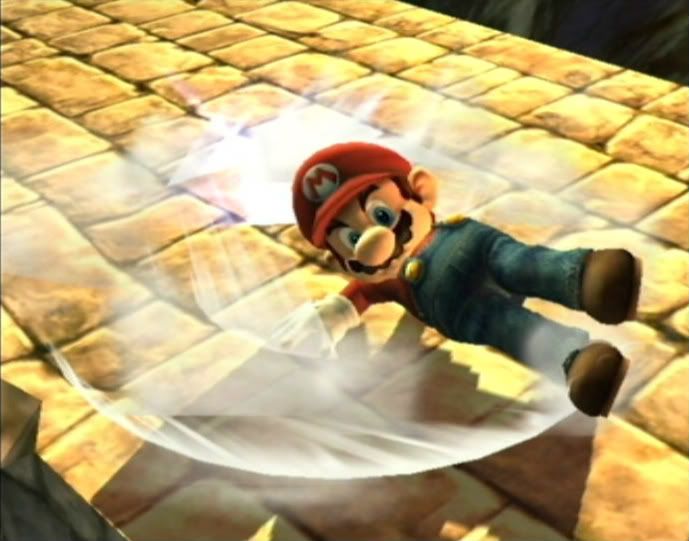
D-Smash - A pretty straightforward attack used to punish attacks and end combos with. This is our most used Smash Attack and most used for good reason. 15% damage is hard to pass up when punishing attacks, and rolls. And with Breakdance Combo being the best jab cancel option in terms of damage, it should be used a lot.
Other ways to combo into D-Smash is with auto-cancel aerials, particularly N-air and U-air. Grounded D-air also works as well though not as safe. Keep in mind though you can string all of these together into one true combo (N-air > Breakdance Combo), though it's somewhat harder to pull off since you have to approach in order for that to work.
While D-Smash has the ability to kill, it probably shouldn't ever be saved for that. Getting in the damage is far more important, and D-Smash can still get the opponent off-stage anyway for edgeguarding and gimps.
More about D-Smash and killing. This is actually quite legit at the edge of stages, and even if you don't kill, the opponent is low enough for gimping capabilities. If you wish to save D-Smash for this, then use PPK Combo more than Breakdance Combo.
Aerial Attacks


N-air - Mario is one of the few characters that retained the sexiness in it's sex kick. It has high knockback at start-up then low towards the end. This makes N-air a versatile kick to use. It can start ground combos, end aerial combos, or even continue them.
Personally, I love the fact that N-air stays a long time, and has a great amount of priority. It basically feels as if people are just running in a wall every time people try to attack Mario while he has the N-air out. Not to mention, he can also aerial approach with this as he can also fastfall to hit the opponent.
However, although the sex kick is indeed sexy, the physics of Brawl doesn't allow it to be as useful as it was in Melee. The floatiness doesn't allow air-dash approaches, which makes N-air approaches a bit telegraphed, and the lack of shield-stun makes N-air pretty easy to shield-grab.
2010 Update: N-air is a pretty good combo breaker. If you're getting juggled then N-air can usually get the job done and get some space between yourself and at the attacker. Also, N-air is able to combat against Metaknight's shuttle loop if he reverses it. Since N-air lasts longer than spotdodge (and is less punishable), then it'll be a good idea to use it then.
N-air as a combo starter has been touched upon already, but should be emphasized here. N-air is best used to set up ground combos. Just about every ground move except U-tilt can combo into N-air, and N-air > F-Smash is a good set-up as well. Keep in mind that vertical spacing is still viable with N-air, and allows these comboes to work when short-hop approaching is being outspaced.

The Epic Spike (F-air) - Ah, the 22-frame spike. To be honest, this is probably our most underrated move and we don't give it enough credit. F-air if fully hopped can spike people downwards to the ground while Mario's animation ends before he lands on the ground. This can lead to potential jab locks, which is good It's on-stage applications are iffy at best though. The spike has to be sweetspotted by hitting with the front part of the fist. The sourspot has a good amount of knockback however, and can potentially kill very well. Yet, that's bad when the intention is the spike.
Although, despite the properties, it still does what it's meant to do: Send the opponent straight downward. Even though it may not kill, it still puts them below the stage, and we all know how Mario loves it when people are below the stage: Easy gimpings.
We should definitely try to apply this more onto our edgeguard game.
2010 Update: To note, F-air actually comes out at Frame 16. The 22 comes from when Mario jumps, which is on Frame 6.
F-air has auto-cancel frames, which can only be accessed in a full-hop, and is accessible after the attack hits, and you can even fast-fall to it. Depending if the opponent techs or not, this can lead into other ground attacks, Jab-locks, or even F-Smash. Nonetheless though, this enhances F-air's on-stage applications and leads to tech-chases.
F-air is a good anti-edgeguard move as well, particularly during your second jump. If spaced correctly, Mario's F-air will hit an incoming edgeguarder and cause them to be spiked. Thanks to Mario's recovery this is do-able without repercussions. This should be used sparingly though, and particularly against opponents with short range.
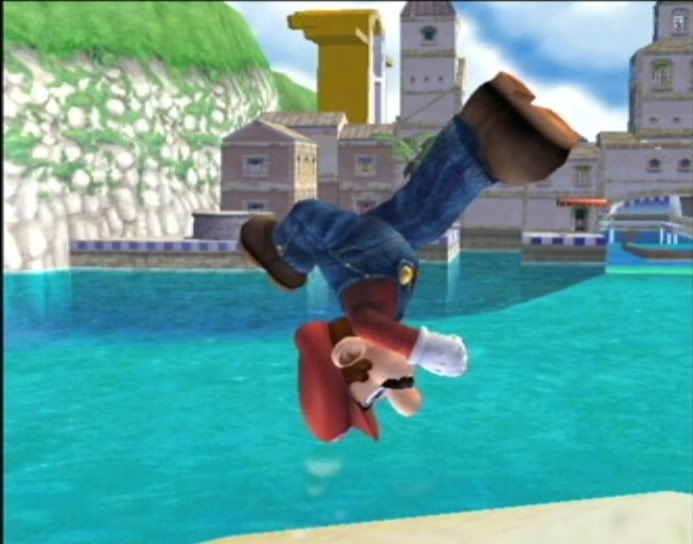
U-air - While U-air chains are still viable, U-air nowadays is mainly used to apply aerial pressure. Things like Auto-Cancel U-air > U-tilt are true combos and set-up for more juggling opportunities. Instead of spamming U-air, it's used in conjunction of other attacks to increase damage. Blind U-air > B-air is actually a true combo as well depending on when the U-air hits, and D-air > U-air is a true combo at low percentages.
U-air is also a decent poke option against aerial opponents, though U-tilt is better. Though, what U-air has what U-tilt doesn't is movement and horizontal range from the front and the back, so Mario can do retreating U-airs added onto his pokes for purposes of spacing, or move closer to increase aerial pressure. What's nice though is the knockback it has, in which it makes a pretty good edgeguard move that can lead to kills or even gimps.
There's not really too much to U-air. It's lagless, has nice range, and decent knockback. It's a straightfoward combo aerial that enhances damage, and that's why Mario likes it.
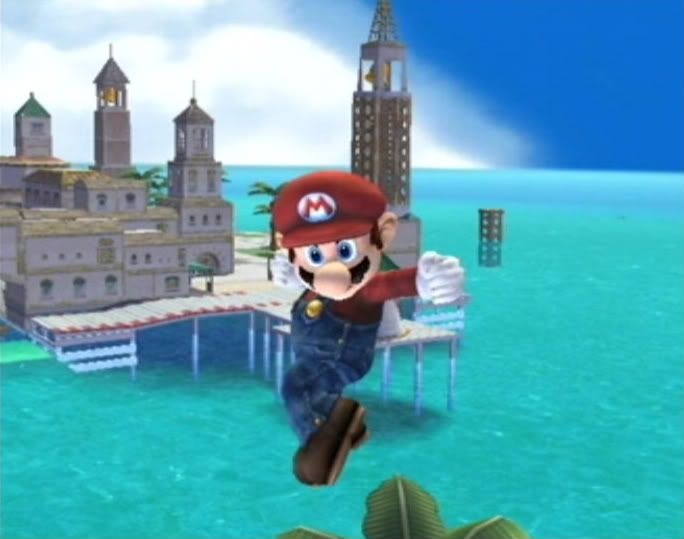
D-air - The Mario Tornado that was originally our Down-B was transferred to being our D-air. Pretty weird, but can't say we can complain. D-air is quite useful. It has good range, covering Mario's entire body (and a bit more). It's a multi-hit that stays out for a long time, and applies shield pressure to the opponent. It also knocks them up in the air which allows for aerial combo start-ups.
Now, there is a reason why I bolded shield pressure, because shield pressure is very important for Mario's approaching. You know the douchebags that love to shieldgrab Mario because of his low range? Well, shield pressure allows that to not happen, and D-air gives out that shield pressure we need. Abuse it on those who love to abuse the shield grabbing. Also good for happy-spotdodgers.
D-air gives a nice amount of damage, therefore making it a good combo-starter. You can do a D-air into another D-air, but it's better to incorperate your other aerials for longer strings of attacks, thus giving more damage.
The bad part about it? D-air lacks the knockback to KO reliably, and it can't gimp. However, it does what it's supposed to do quite well.
2010 Update: D-air can punish airdodges and can immediately go into other aerials before retaliation. Grounded D-air has fixed knockback for any percentage so that can be useful to going ground options, particularly smash attacks.
Furthermore, Full-Hopped D-airs allows Mario to move in and past opponents to weave away from shield grabs and legitmately increase shield pressure without proper retaliation. Mario can also move in and out with D-air to give pressure in general and demands a reaction. Keep in mind this can also be done with short-hops, but you'll be awfully close to the ground if not actually landing, so it's suspectible to be punished if done that way.
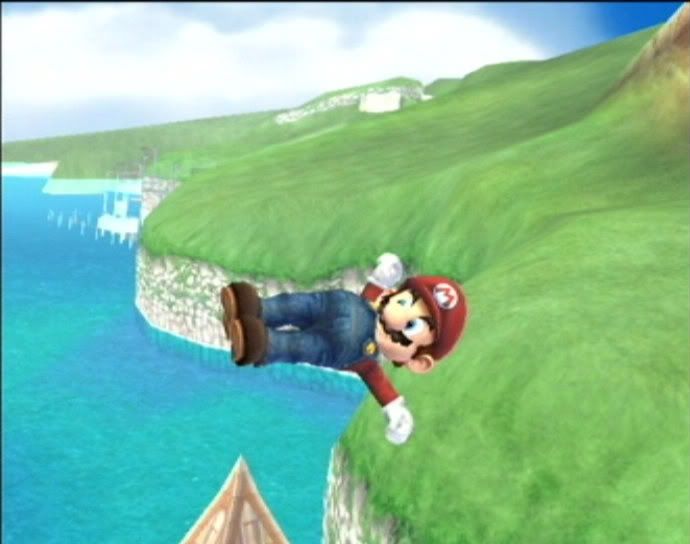
B-air - Undoubtedly Mario's best aerial. It has the best range, good knockback, virtually lagless, and you can do two b-airs in one short hop. It can start up combos, or continue them, and you can do a WoP off the stage with B-air for gimping. Last but not least, this is the aerial that Mario will use for spacing and contesting other long-ranged aerials to poke through. It also has a bit of a lingering hitbox, so you can fastfall with the move to hit an evasive opponent. B-air can also be used to help Mario's defensive game. More on that later.
The bad part about this aerial is that it's easily read. If you're coming from behind, you're going to use B-air, and the douches are gonna grab you. But as long as you're smart about it, this shouldn't be much of a problem unless it's the ****ed penguin.
Use this aerial. a lot. If you don't use it then Mario hates you.
2010 Update: B-air is the best aerial for vertical spacing, which is attacking from a 90 degree angle. It actually avoids possible grabs (Even from Chaingrab), and Mario's aerial speed is fast enough that Mario can retreat to avoid any form of punishment, and do this in a continous motion over time. The vast majority of opponents cannot grab this. However, some can use a tilt attack to stop this, particularly angled up.
The knockback of B-air is pretty good, and is the best of all of Mario's aerials. It degenerates overtime, so hitting with the B-air late and auto-canceling will lead into other combos, and B-air in particular is the main contender for comboing into F-Smash since it allows a stutter-step. B-air is still Mario's best aerial for it's versatility.
RAR B-air is nice too.
Grab Attacks
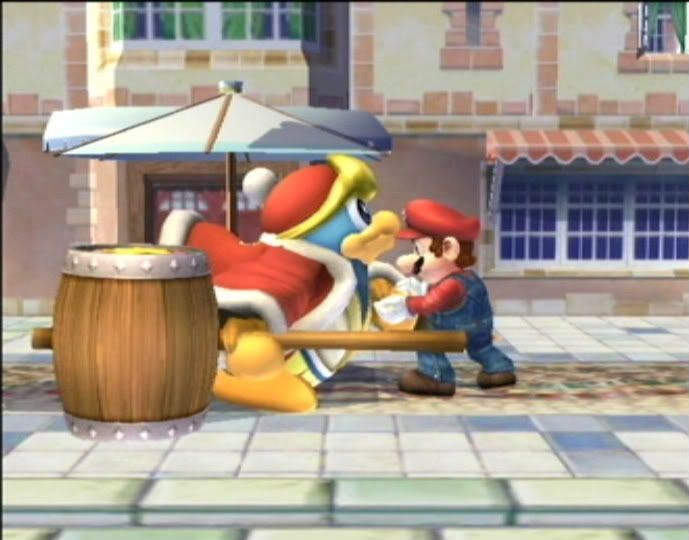

Grab – Mario’s grab range is pretty poor compared to everyone elses. He has one of the lowest ranges in the game. This is all right though, because Mario is easily able to shield-grab attacks, and pivot grabs increase his grab range by three times. Also, walking grabs increase his range as well.
Do try to not use his dash grab however. It’s bad to have short range, but it’s worse if you lag while doing it, being open for attack.
2010 Update: Jab-Jab-Grab is a popular mix-up for just about any Mario player. Particularly useful on the spacies since Breakdance Combo or PPK Combo aren't guaranteed. Pivot Grabs have a good amount of mindgame potential and is a substitute for retaliating aerial attacks. Keep in mind that pivot grab is capable of grabbing out of Metaknight's Tornado.
For the most part, landing grabs aren't hard at all as long as you're able to set it up.
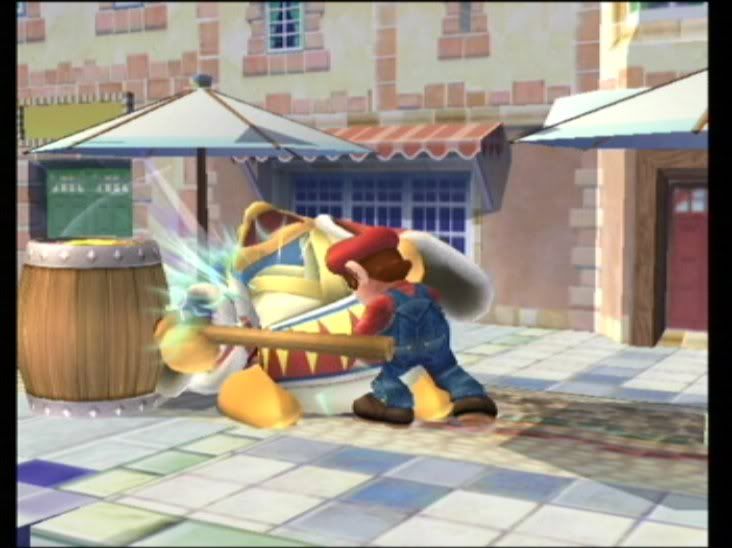
Pummel – Unlike Mario’s jabs, this is pretty slow with little reward (3% per hit). You’ll be able to get in one, maybe two hits before your opponent shakes out of it, and you’ll only be able to get in more if your opponent isn’t shaking out at the very beginning of it. Not much else to add here, but eh, damage is damage.
2010 Update: Don't be afraid to spam this at higher percents. Adds on damage and refreshes your moves. Considered to be good if you failed a kill attempt.
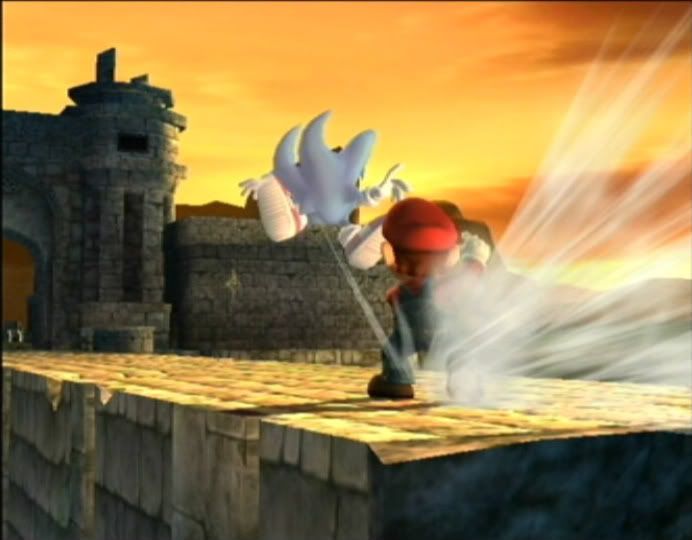
F-Throw – F-Throw is currently a contender for best throw, mainly for how fast it is and it's short set-ups at low percents. F-Throw can lead into tech-chases which can go into another grab. It's also been proven that F-throw > (Stutter-Step) F-Smash works on Fox, maybe others fast-fallers and heavies at 0%, which gives 27% damage total. F-Throw > Fireball > etc. is also noted as a mindgame technique as well. At higher percents F-throw is used for it's damage (9%), and the moderately low knockback allows for easier follow-ups, though nothing is guaranteed.
More on F-throw > Fireball: This is actually used for off-stage purposes. F-throw an opponent off the stage, then fireball to put opponents in a bad position. Even if the opponent avoids the fireball it still gives Mario the opporunity to apply his edgeguard options.
Heading into the theory-craft area: Testing has showed that F-throw has a possible chaingrab on heavies and fast-fallers at 0%, involving buffered shield grabs. So far it's only proven to work for two throws. Though if staled, it can work until 30%. Would be nice to get factual information here.
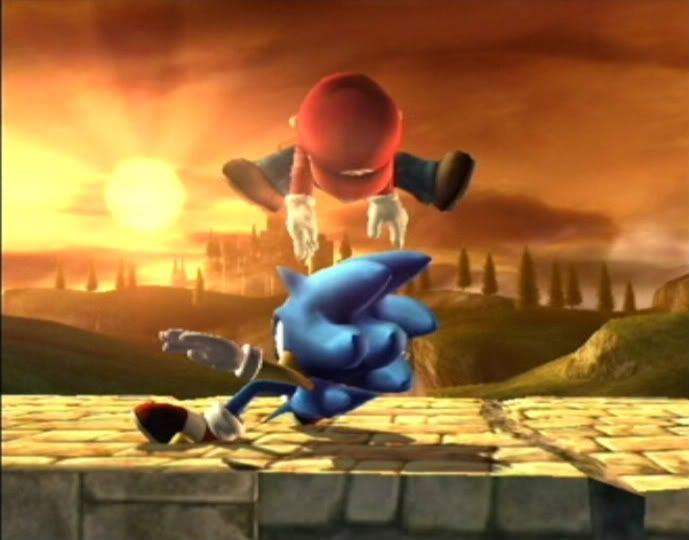
D-Throw – Not as awesome as initially thought to be. Considering the low damage (6%), and the fact that the effectiveness is character-specific (Heavies and Fast-fallers), D-throw should be used in moderation. That doesn't dethrone it from being a good throw though. A low percents it is still a decent set-up for combos, and D-throw > U-tilt Lock is quite legit. At around 50% or so however, D-throw stops being a good set-up since it'll being to pop up opponents too high.
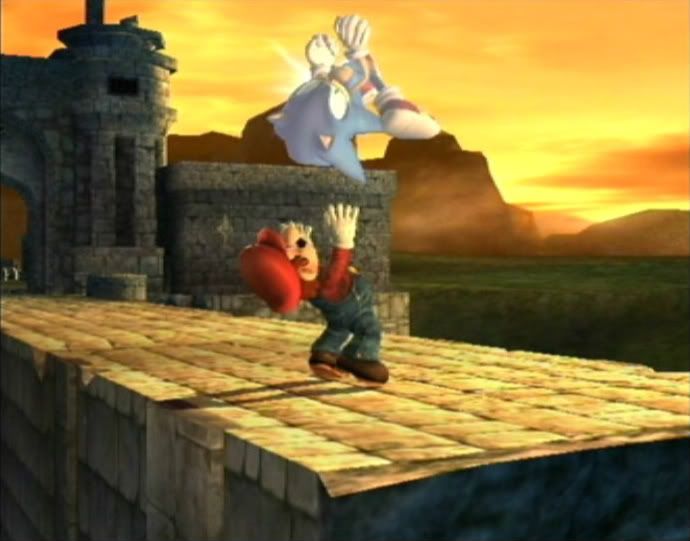
U-throw –
U-Throw is a throw you'll want to use for it's damage (8%). That's 2% more than D-throw, and that adds up. Once D-throw stops being effective for set-ups, U-throw becomes viable to use if only because the damage is greater. While the knockback is rather high, this works in our favor for chasing the opponent with grounded attacks, particularly U-tilt and (Sliding/DAC) U-Smash.
A small thing to note is at 0%, you'll want to use U-Throw (if you have the grab) if you wish to set up aerial combos against heavies and fast-fallers. Though honestly F-throw should be used in that case.

B-throw – This pretty much went from decent to bad as two years passed by. The problems with B-throw are glaringly obvious. Not only is it's knockback weak for a kill move, but due to the introduction of Momentum Breaking, the kill potential of B-throw is weakened even further to the point where it's comparable to U-throw (190%). Furthermore, this move is insanely easy to DI, and the knockback properties make it even worse so edgeguard tactics can't even work with B-throw because they'll be too high. Lastly, Mario has ending lag on this throw, so he can't follow-up with attacks easily.
Only thing good about B-throw is the damage, which is 12%. Might be decent to use from time to time, but overall B-throw won't be seeing much sunlight during competitive play. Depending on stage and position though, this can still be used to kill, so this won't be forgotten. Keep B-throw in your back-pocket if you need a kill and you're in a the right position for it.
Special Attacks
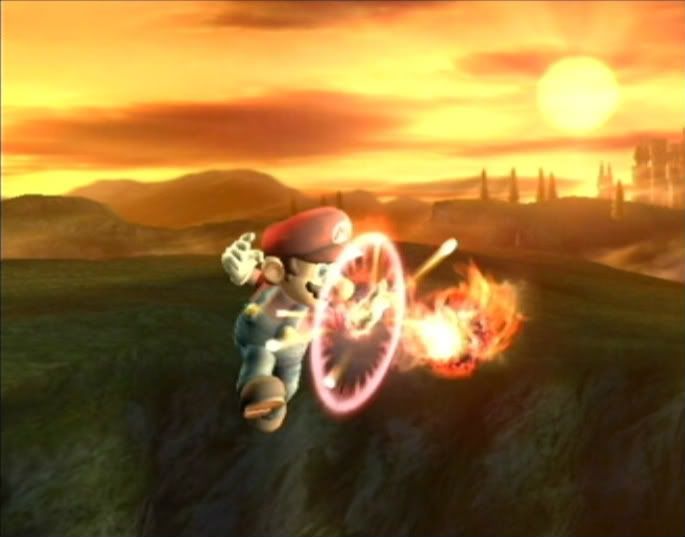

Fireball – Fireballs, on their own, is a pretty bad projectile for the general use of it. However, Mario uses them in a way that makes them very important to his game. Fireball approaching is the very basic of Mario’s approach method, and the main use of the fireballs. My favorite use for the fireball approach method is Fireball approach -> F-tilt (Semi-lock) -> Whatever else goes in my head (Usually N-air).
There are however, other uses of the fireball. You can also use it for an anti-approach method, pressuring, and for camping (YES you can camp with Fireballs. More on that later). There are a lot of uses for Fireballs than just for approaching and retreating. You can also use them for edgeguarding, which is quite good because since it has very little knockback, it allows Mario to get off an aerial that is a “True Combo”, and we all know about the Epic Fireball Spike.
However, it has some pretty bad damage racking. The speed, although it helps Mario, could be better used if it was increased, and the range isn’t far enough to allow Mario to have a very effective camp game. Still, this is very essential to Mario’s game and should not be neglected at all.
2010 Update: Camp, Camp, Camp. Fireball camping is an extremely good way to get safe, consistent damage without chance of punishment. B-Reversal Fireballs helps to retreat, and 6% damage per hit is nothing to laugh off.
Fireball spam is great for edgeguarding. It kills multi-jumps, and can even potentially stop planking. Getting hit with a fireball makes the opponent so vulnerable off-stage that nearly all of Mario's edgeguard options open up. For the most part, Fireballs are well-established into Mario's Metagame.

Cape – If there was any broken move in Mario’s moveset, it’d be this. The Cape is very powerful and technical ability with an abundance of variety to it. It can stop incoming approaches, allow counter-attacks, can be comboed into for a continuation of attacks (U-air -> U-air -> Cape -> N-air -> Jabs can work), and destroys projectile camping. The Cape can do so many things that it even makes Pit’s Wannabe Cape a complete pansy to it.
Of course, its main use is edgeguarding. We can’t refute that, but it application of general use goes far beyond that. That said, we don’t use Cape enough on-stage, and rely on it too heavily for gimping when aerials and FLUDD could very do the trick alone. The Cape also stuns the opponent for number of frames if they happen to be aerial and land on the stage (Thus, CILL; Cape Induced Landing Lag), which would give off free attacks, maybe even a free F-Smash. More practical application of Cape will be spoken of later on.
The one thing I’d like to mention specifically is Cape Teleport. I’ve been able to use this in a friendly and it works really well. The way it works is that you have to cape the opponent right before he grabs the ledge. He’ll have no invincibility frames, and won’t be able to move. This is an easy B-air stage spike that can easily make grabbing the ledge dangerous if the Mario community was able to master this rather effectively. Cape Teleport specifically should be looked into.
2010 Update: Cape Stall should be noted for being a good stall tactic to avoid follow-up attacks. Cape Jump is an excellent aerial interceptor. This intercepts any aerial with short range or has the hurtbox extended. This also applies to vertical spacing which allows Mario to avoid being grabbed or attacked in general, and unlike Grounded Capes, Mario can move quickly after he finishes.
One thing to note is Sliding Cape, which is the same as Sliding U-Smash. A decent mindgame tool perhaps, but I personally never seen a practical use of it as of yet. Cape Dash for platforms is a good mindgame tool to psyche out your opponent, and Cape Glide in general is quick and easy to follow-up with.
Cape is actually being used less off-stage in favor of other tactics, which is good, but it still needs to be used more on-stage. Cape Teleport still needs to be looked into as well.
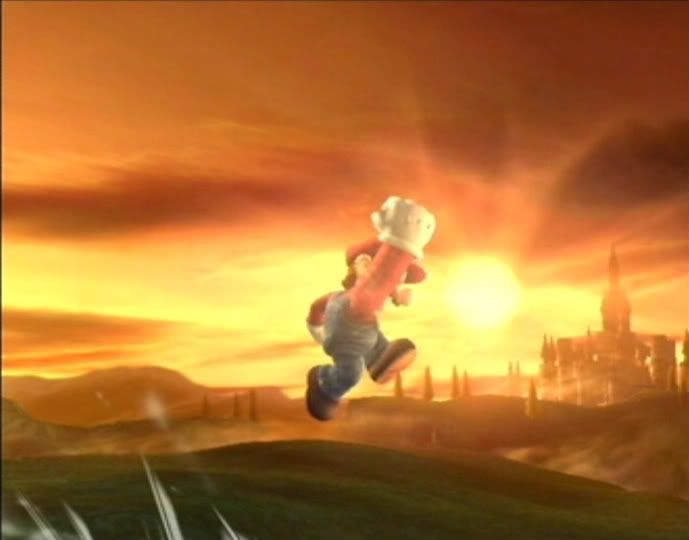
Super Jump Punch - Two words: Invincibility frames. SJP has 3 frames of invincibility and a crazy large hitbox, which makes it the perfect Out-of-shield option. It has a small spike at the end of the last hit, which means the opponent cannot react at all while Mario is in his freefall state back to the ground. It racks up damage fairly well, even when staled out, and it breaks through multi-hit attacks due to it’s properties.
This move -can- kill by the way. There are a few times where I was able to knock the opponent to the top of the screen, then fully jump towards him and use SJP, the spike resulting the opponent to hit the ceiling and get KOed. It’s a nice note.
2010 Update: The 2008 Post pretty much says the majority. One thing to add though is you can control the trajectory of Mario's SJP.
-A regular SJP is a 70 degree angle.
-Holding forward makes Mario jump to a 45 degree angle.
-Holding Up, then back sends Mario up to a 90 degree angle, and actually increases the jump range, to the point where Mario can land at the top Battlefield platform.
-Holding backwards will make a reverse SJP.
More things to note is SJP OOS is the fastest OOS option in the entire game, and the frames of invincibility are from frames 3-6. A bad note is SJP is an average recovery move, but generally very safe and hard to contest for most characters.
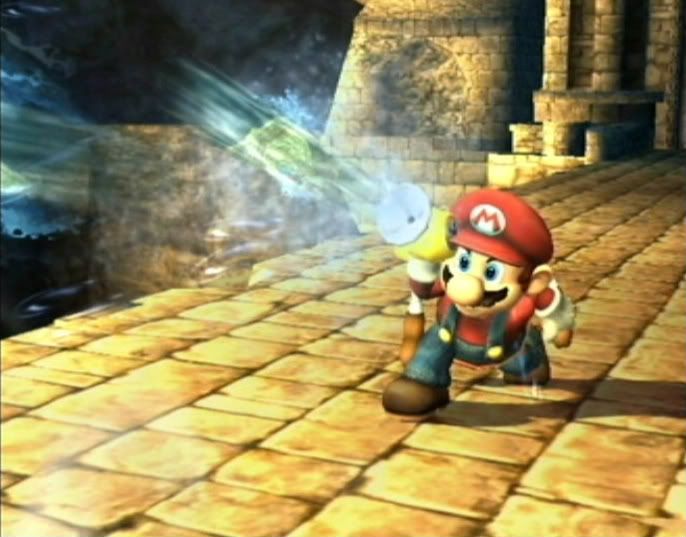
FLUDD – This ain't 2008 anymore. FLUDD is a well-established ability to Mario. The greatest use of FLUDD is it's positioning power, which screws up opponent's spacing and sets them into situations that are undesirable and demands an on-the-fly reaction.
Techniques to look at are FIHL and FAK (FLUDD-Approach-KILL). FIHL causes lag, and FAK makes opponents rethink their approach methods. FLUDD also completely blows away item-based projectiles that aren't bananas, and can cut through some projectiles, and even douses out Firebreaths from Bowser and Charizard.
Edgeguarding is still it's main use however, for obvious reasons. One thing I like to note however is on certain stages, FLUDD can be used to push opponents under the stage if they're recovering from directly below the stage, particularly on Final Destination.
Just to note: FLUDD is always at it's best when fully charged. There is no time when half-charge is better than full-charge, so always keep FLUDD fully charged for everything.
----------
Necessities
[NS]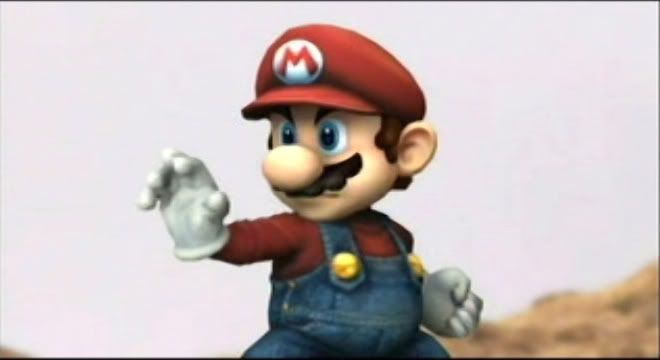
While Mario has a large amount of mix-ups, there are actually things that all Marios need to do to gain the momentum in matches. This is not to be confused with tactics, which explains his options. This directly involves Mario's core gameplay and needs to be used by all Marios.
Shield Pressure
This is a no-brainer. Shielding is the best defensive strategy in the game. Shield Pressure is absolutely important to discouraging this. Fireballs are needed to demand the opponent to shield, so D-air can be applied to ruin shields. To apply further, you can drift behind the opponent and B-air, or you can land behind and U-Smash. Just this combination hurts shields to a good degree, and the majority of big targets (Chaingrab, DK, Snake) are opened to be shield-poked right after this. Dash Attack, B-air (vertically spaced), or just more D-air can get the job done. As a note, Staying in front of the opponent is usually a bad idea, and using this on smaller characters is a harder task, and sometimes impossible against characters like Diddy.
For an example of our favorite Mario, 0:06 - 0:08 shows a decent example
Anti-Air
This is perhaps the number one reason why Mario's ground game is good. U-tilt and U-Smash are excellent Anti-Air attacks. Just these two moves alone has made me a more grounded Mario. U-tilt outproitizes a lot of aerials when spaced, and U-Smash just outright outrange any aerial that doesn't come from a sword (with a few exceptions of course). I'd go as far as to say that U-Smash should be prioritized more for anti-air more than killing, and grabs like U-throw and B-Throw should be used as set-ups just to exploit this.
This is why Mario is at his best when he has all of the options. U-Smash and U-tilt are absolutes. If it can't be beaten, then there's no reason to keep trying. This is where mix-ups and prediction come in. If there is no aerial to beat Mario's Anti-Air, then more than likely, the opponent is going to air dodge, or stay away. This can lead to Sliding U-Smashes, use of aerials, etc.. Using Anti-air is extremely important and should be implemented.
Avoiding Damage is more important than Giving Damage
A smarter way of saying don't run into ****. I still see a lot of Marios go offensive, then get destroyed because they can't get inside, so I believe this needs to be made clear. Spacing, defense, and knowing what works are far more important then hoping you'll get that U-air off, and hoping you'll be able to land in front of the opponent to attack.
This goes hand-in-hand with avoiding KOs. If you know it works, do it, but one needs to realize that getting hungry for the KO won't do Mario any good. If you have to wait till 200% to score a KO, then do so. As long as you have less damage and up in stocks, you don't need to be going out of your safe zone.
Tactics
[TC]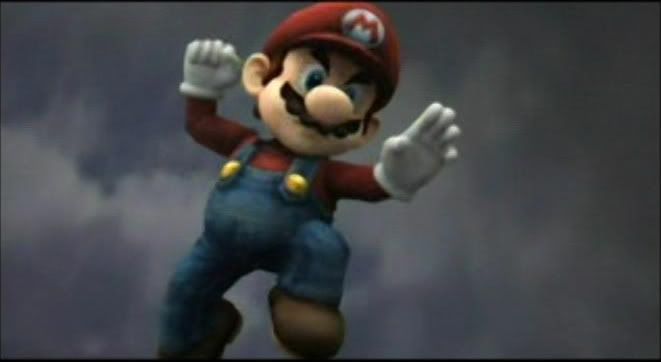
Sometimes there are times when you’re at the corner with seemingly no way out. However, Mario is able to plow his way through it strategic thinking and good execution. In this section I’ll list of specific tactics used on the battlefield.
Camping

As said before, you can camp with Fireballs. However, it takes more than fireballs to effectively camp. It also takes FLUDD, Cape, B-air/N-air, OOS options, and ledge usage. Fireballs can’t be needlessly spammed. Those will just be powershielded, which is why many say fireballs are a crappy camp projectile. However, Fireballs go in different trajectories from the air and when grounded, and you can also move backward and forward while using them. Doing this will break your opponent’s timing and rhythm and eventually causes them to take damage.
FLUDD is used to outright kill aerial approaches, in which fireballs don’t do so well in the air due to being affected by gravity. Approach killing and FIHL allows Mario to counterattack with aerials and perhaps Smash attacks. Cape can also be used as an anti-approach mechanism due to its properties and allows for counterattacks as well. Using both of these is essential for stopping attacks and in return not taking any damage. Cape is also essential to combat against other campers since it reflects projectiles.
When the enemy is so close that FLUDD won’t work and you won’t have time to pull out a cape, that’s when N-air, B-air, and OOS options come in. You use B-air to contest range, while N-air to quickly react to an incoming attack. Up-B OOS is best used when dealing with a multihit attack that outranges B-air and N-air.
Camping is essentially effective for Mario due to his superb gimping skills. <--- Nah.
There are two variants of Mario's camping. There is Passive, and then there is Aggressive. Passive Camping is simply letting your opponent act while you hang back patiently and camp him to death. Aggressive Camping is quite literally camping until there's an opening, not to be confused with Fireball Approaching where you're running with your fireball, but rather waiting for your opponent to screw up.
If you really wanna be a douche, you can apply your Anti-Air moves U-Smash and U-tilt to stop aerials up close then run away. But at that point I'd say you were trying to run the timer. Which takes me to the next point.
Running the Timer
It's not fun, it's boring, and most definitely not the glamorous action to take, but it's still a legit strategy in competitive gaming and is usually looked down upon for obvious reasons. To be honest, I don't think Mario in particularly will have to do this a lot in order to win matches, unless you're up against something like an extremely good Ice Climbers where one grab truly equates to one stock. In a defensive and cheap game like Brawl, actions like these need to be taken into consideration however. Potentials like Ice Climbers, Chaingrab, and perhaps Olimar can be far too hard to fight head on, so taking the lead then... well, camping can lead to (crappy) victories.
While it's discouraged, if you're playing to win, it shouldn't matter.
Getting Past the Range Problem
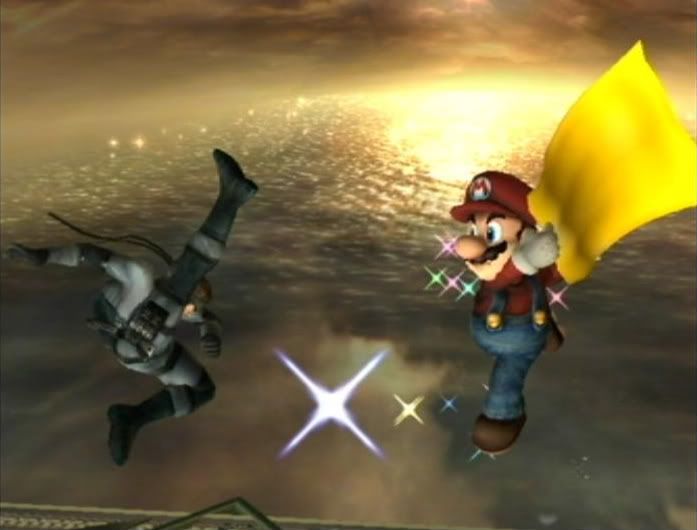
When an opponent is big on spacing, this poses as a big nuisance to Mario. Opponents like Snake, G&W, and Metaknight all pose this problem by a considerable margin. However, even Mario has an answer to that as well: The Cape.
The Cape itself has good range and transcended priority. This mean the cape does not clash with anything whatsoever, no matter what the case. The only way it gets out-prioritized is through a faster attack or if another attack has more range. So do you know why the cape is so good for this? That’s right, because it reverses attacks. Snake in particular has plenty of range, but the cape has just enough range to reverse his F-tilt and U-tilt. N-air in particular is very easy to cape since it’s not disjointed at all. This also applies to G&W since his moves, although disjointed, are low ranged and able to be caped. Metaknight gets a break from this since he has both long and disjointed range, but can still be used to stop his spacing methods and approaches.
2010 Update: The above stays true even to this day. To note though, Cape Jump and Pivot/Reverse Cape helps perform this tremendously.
Charging Smashes
Seriously, do it. It works. I can't really say much on this topic, since there isn't really much to say except that it actually does work. U-Smash is phenominal at performing this due to Anti-Air purposes, and D-Smash increases the kill potential that's hardly used. F-Smash, while it's the hardest to connect, has the largest range and can lead to deadly mindgames, or even scare tactics.
The best time to charge Smashes are for when opponents are getting up from the ledge, or if they're approaching from the air (U-Smash). Other methods are mostly mindgame oriented.
Metagame Improvements
[MI]Here are my suggestions to improve Mario's Metagame, or at least should be looked into.
MOAR CAPE!

In general, we need to start doing less of exploiting Cape’s use off-stage and do more of it on-stage for reasons I’ve stated throughout this whole essay. The Cape is ****, but our aerials can do some molesting too. We need to start using Cape Jump to poke shields and avoid aerial attacks, and there’s even the new Cape Dash that Famous brought up that brings in some new possibilities as well. Some of these new exploits can turn these matches around for us.
2010 Update: More Cape on-stage, please.
Learn Mario's Moveset


The fact that it took so long to figure out that Mario's U-tilt and U-Smash excellent Anti-air moves is kinda... well, embarrassing. In all, before we do anything else we need to take a full understanding of Mario's moveset as a whole before going into techniques that could very well be unnecessary. This is why I always advocate frame data on the same level as this as to help us understand more. We also need to look into what we can do with Mario's natural, basic moveset from the ground up, from spacing, juggling, to killing, then we can start putting pieces together and delve into the advanced stages.
This is of the utmost importance. I cannot stress this enough.
Apply Techniques
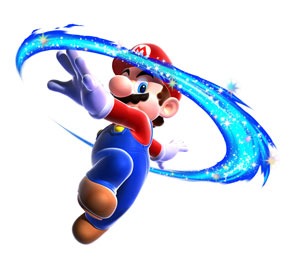

This is from simple techs like Cape Glide, to advanced techniques like DACIT and JCT. Overall, Mario has plenty technical aspects of him that quite many choose to ignore. Well,
Heck, even things like RAR and B-Reversal aren't seen very much.
Enthusiasm, Please!


Improving Matchups
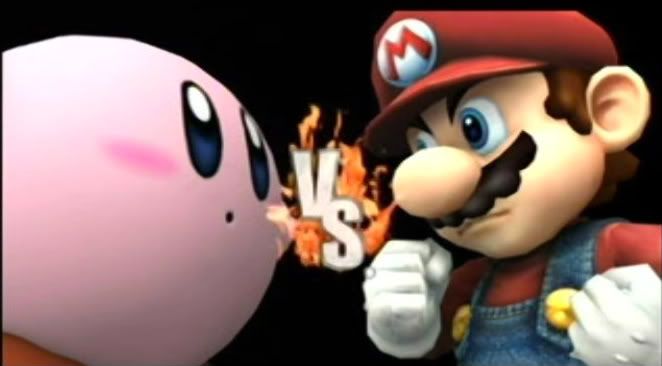
While this is important, I'd put it at the bottom of the to-do list. Until the above is done we can't really improve match-ups. In fact, it should come naturally the more we learn and apply. Overall we still have plenty of work to do before going into this.
---
And that’s it for me. Are there any thoughts and opinions about this? Debate? Feel free.


 .
.